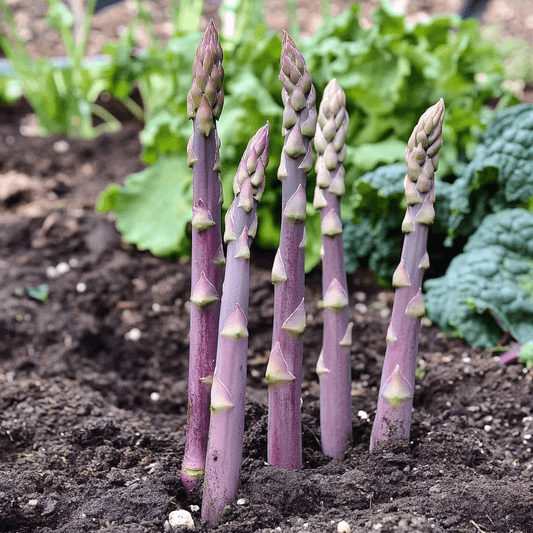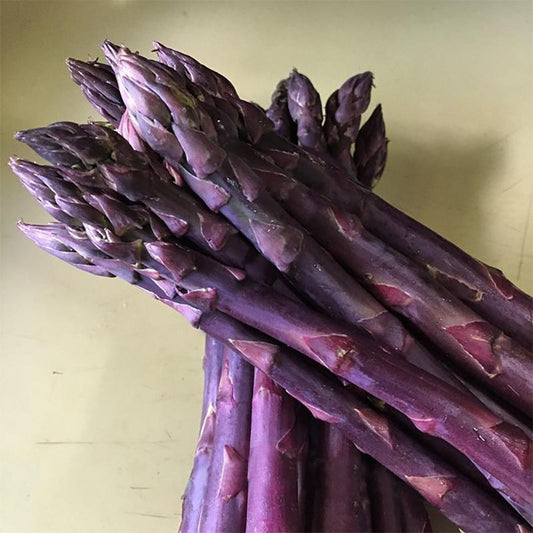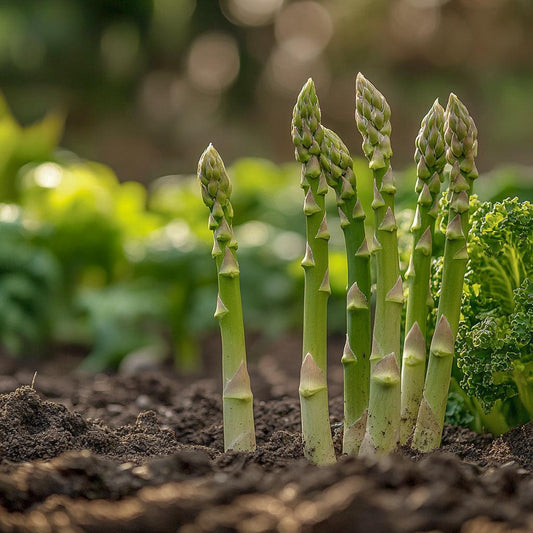The fundamental considerations and subtle nuances of growing and caring for asparagus crowns are beyond the scope of this introduction to plant care. Please see our Resource Center where we offer additional instructional videos and articles, as well as our bookstore.
Cultural Requirements
Asparagus is a hardy perennial, native to Western Europe, which is usually started from crowns but can also be grown from seed. It grows well in most areas of the country. Asparagus beds can remain productive for 10–20 years, so be sure to plant them in a permanent location that contains rich, fertile, well-drained soil. The soil pH should be between 7.0 and 7.2; use a pH meter to check. Gopher traps, wire barriers and/or wire baskets should be installed prior to planting.
Heeling In
When your bare root asparagus crowns arrive, open the plastic bags immediately. It is best to plant them right away, within a week of delivery. However, if you cannot plant right away, you may “heel in” the plants to protect them and keep them alive (but still dormant) until you are able to plant them in their permanent spot.
Outdoors: To heel in bare root plants outside, pick a location that is shielded from wind. Dig a trench about twice as deep as the roots are long, with one side of the trench sloping at a 45° angle. Place in the hole roots side down, so that the plant is supported by the sloping side. Cover the roots with soil or sand and gently tamp down to avoid air pockets. Periodically check the root area, keeping the soil moist.
Indoors: To heel in bare root asparagus indoors, whether due to snow or a frozen ground, choose a cool place like a root cellar, basement, or garage. It’s important to choose a place where the temperature stays between 38°F and 45°F. This is important so the roots neither freeze, nor does the plant break dormancy. Place the roots in a container with soil or sand and be sure to keep the root area moist.
Planting & Growing
Be sure the soil is at least 50°F and the pH is around 7.0. If your soil is very heavy (clay), amend the soil with some good compost and add some fertilizer with little or no nitrogen, with lots of phosphorus and potassium. Try Ultra Bloom 0-10-10.
Dig a trench, 6–8” deep with 4’ between rows. Spread out the roots in the trench and space the crowns about 18” apart. Fill in the trench with soil, covering the crowns 2” deep at first.
As the plants grow and shoots emerge, begin covering the crowns with more soil until the trench becomes level with the soil surface. Keep the plants well watered and weeded to aid their growth.
Ideally, you do not want to harvest any shoots in the first year, allowing the spears to set ferns and direct their energy back into becoming stronger plants. In the second year, you can begin light harvesting of the spears and the third season regular harvesting can begin. Harvest season generally lasts about 8–12 weeks. Cut asparagus 1–2” below the ground and at least 2” above the crown.







4 comments
Tom, I would go ahead and plant them and see if they grow.
My crowns have dried out. Is it worth planting them?
Molly, you would just plant as normal. Try not to break off the new shoot as you are planting and maybe not cover the new shoot deeply with soil. You are not going to do anything with the new plants the first couple of years, just let them grow.
Planting crowns tomorrow. There is some “shoot” growth out of the crowns. How should I deal with them in the planting process please?